
Astragalus is a large genus of over 3,000 species of herbs and small shrubs, belonging to the legume family Fabaceae and the subfamily Faboideae. It is the largest genus of plants in terms of described species. The genus is native to temperate regions of the Northern Hemisphere. Common names include milkvetch, locoweed and goat's-thorn. Some pale-flowered vetches are similar in appearance, but they are more vine-like than Astragalus.

Astragalus lentiginosus Astragalus lentiginosus is a species of legume native to western North America where it grows in a range of habitats. Common names include spotted locoweed and freckled milkvetch. There are a great number of wild varieties. The flower and the fruit of an individual plant are generally needed to identify the specific variety.

Astragalus trichopodus is a species of legume known by the common name Santa Barbara milk vetch. It is native to southern California and Baja California, where it grows in several types of open habitat, including in the Transverse Ranges and Mojave Desert.
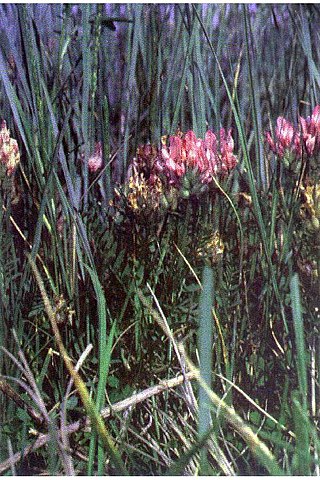
Astragalus agrestis is a species of milkvetch known by the common names purple milkvetch, purple loco, and field milkvetch. It is native to much of western and northern North America from most of Canada to the southwestern United States, as well as eastern Asia. It grows in vernally moist areas such as meadows, and is often found in sagebrush.
Astragalus anxius is a rare species of milkvetch known by the common names troubled milkvetch and Ash Valley milkvetch. It is endemic to northern Lassen County, California, where it is critically imperiled. It was formally described in 1992.
Astragalus claranus is a rare species of milkvetch known by the common names Clara Hunt's milkvetch and Napa milkvetch. It is endemic to northern California where it is known from only four or five occurrences along the border between Sonoma and Napa Counties. It is a federally listed endangered species.
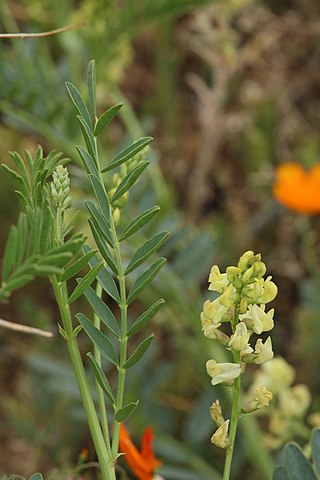
Astragalus douglasii is a species of milkvetch known by the common name Douglas's milkvetch. It is native to California and Baja California, where it can be found in many types of desert, valley, chaparral and woodlands, and montane habitats, usually below 8,000 feet (2,400 m) elevation.
Astragalus funereus is an uncommon species of milkvetch known by the common names Funeral Mountain milkvetch and black milkvetch.

Astragalus gilmanii is a species of milkvetch known by the common name Gilman's milkvetch. It is native to the desert scrub and woodland of Nevada, the California Sierra Nevada and Inyo Mountains, and it is known from a few locations in the Panamint Range adjacent to Death Valley in California.
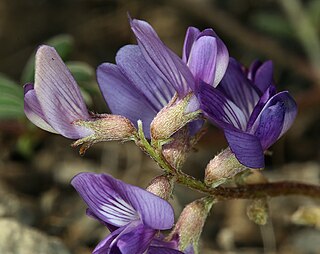
Astragalus inyoensis is a species of milkvetch known by the common name Inyo milkvetch.

Astragalus kentrophyta is a species of milkvetch known by the common name spiny milkvetch. It is native to western North America from central to west Canada, to California, to New Mexico. It grows in rocky mountainous areas, such as the Sierra Nevada, and on plateaus.
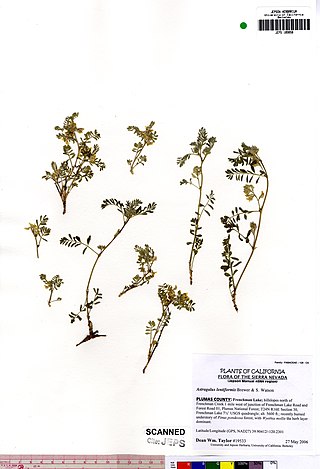
Astragalus lentiformis is a species of milkvetch known by the common name lens-pod milkvetch. It is endemic to the Sierra Nevada in eastern Plumas County, California, where it grows in chaparral scrub and coniferous forests.
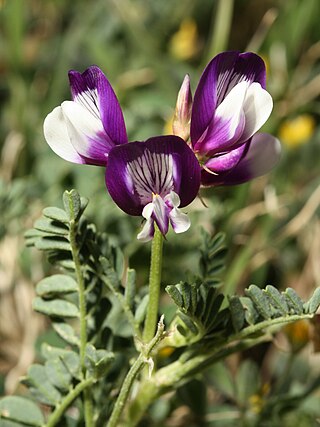
Astragalus nuttallianus is a species of milkvetch known by the common names smallflower milkvetch and turkeypeas. It is native to the southwestern and south central United States and northern Mexico, where it can be found in many types of habitat, often in dry areas.

Astragalus nuttallii is a species of milkvetch known by the common name Nuttall's milkvetch. It is native to California and Baja California, where it grows in the sandy soils of coastal habitat. This is a perennial herb forming thick, tangled clumps of hairy to hairless stems up to a meter in length. The abundant leaves are up to 17 centimeters in length and made up of many oval-shaped leaflets. The inflorescence is a large, dense body of up to 125 flowers, each around 1 to 1.5 centimeters long. The flowers are dull cream-colored and sometimes purple-tinted. The fruit is an inflated legume pod up to 6 centimeters long which dries to a papery texture and contains many seeds in its single chamber. One variety of this species, the ocean bluff milkvetch is endemic to the Central Coast of California.
Astragalus pachypus is a species of milkvetch known by the common name thickpod milkvetch. It is endemic to California, where it is known from many types of open habitat across the southern half of the state. This is a robust perennial herb forming stands of tough, wiry stems up to 80 centimeters tall. Leaves are up to about 16 centimeters long and are made up of many narrow leaflets. The plant flowers in inflorescences of 4 to 28 cream-colored flowers. The fruit is a sharp-beaked legume pod up to about 3 centimeters long which dries to a leathery, mostly hairless texture. There are two varieties of this species. The rarer, Jaeger's bush milkvetch, is known mostly from western Riverside County.
Astragalus lentiginosus var. pseudiodanthus, synonym Astragalus pseudiodanthus, is a variety of the species Astragalus lentiginosus, a milkvetch. It is known by the common name Tonopah milkvetch. It is native to the Great Basin deserts of Nevada and eastern California, such as the Tonopah area, where it grows in sandy habitat.

Astragalus purshii is a species of milkvetch known by the common names woollypod milkvetch and Pursh's milkvetch.

Astragalus pycnostachyus is a species of milkvetch known by the common name marsh milkvetch. It is endemic to the coastline of California, where it grows in wet saline habitat such as marshes.

Astragalus webberi is a rare species of milkvetch known by the common name Webber's milkvetch. It is endemic to the coniferous forests in the Sierra Nevada, in Plumas County, eastern California.

Astragalus australis is a species of flowering plant in the legume family known by the common name Indian milkvetch. It is native to much of the Northern Hemisphere, including northern North America, Europe, and temperate Asia.
















